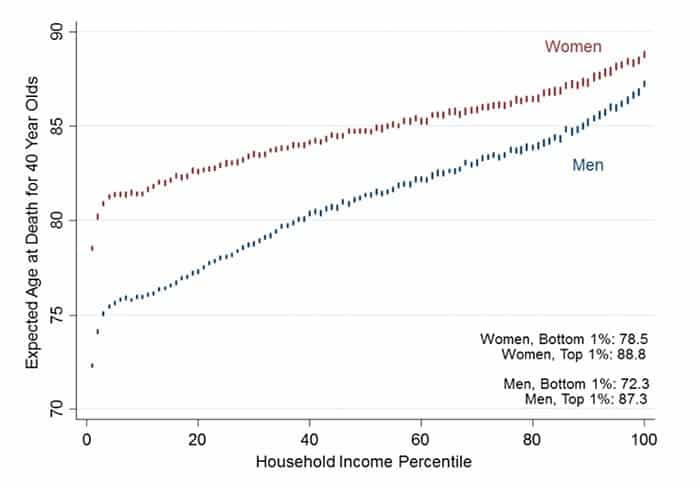The richest American men may live up to 15 years longer than the poorest ones, and the richest women 10 years more than their poorest counterparts, a new study found.

Image via behance
Life becomes a whole lot better and easier when you have wads of cash to throw at your problems until they go away — but also way healthier and longer, a new Harvard study finds. An analysis of 1.4 billion Internal Revenue Service records, focusing on the link between income and life expectancy, found that low-income residents in wealthy areas such as New York City and San Francisco live longer on average than those in poorer regions.
This comes down in part to a healthier lifestyle in more engaging communities; low-income residents in wealthier cities are less likely to drink as much, they exercise more and have lower rates of obesity than residents with similar incomes in less affluent cities. But by themselves, these factors aren’t enough to explain the life expectancy gap that the team found. And, as David Cutler, the Otto Eckstein Professor of Applied Economics and a professor at the Harvard Kennedy School and the Harvard T.H. Chan School of Public Health says, it’s unclear what other factors might contribute to the difference.
“It’s not an overwhelming correlation with medical care or insurance coverage,” he said. “It’s not that the labor market is getting better — it’s not correlated with unemployment, or the expansion or contraction of the labor force, or how socially connected people feel. The only thing it seems to be correlated with is how educated and affluent the area is, so low-income people live longer in New York or San Francisco, and they live shorter in the industrial Midwest.”
“Previously, we could say what life expectancy was like in Massachusetts as compared to Michigan, but the problem is that Massachusetts is much richer than Michigan, and we know mortality varies with income,” he continued. “What we wanted to do was compare the same people in both cities — a shopkeeper in Detroit with a shopkeeper in Boston, not a biotech executive. That’s what we can do with this data that people haven’t been able to do previously.”

Cutler and his co-authors, including former Harvard Economics Professor Raj Chetty now at Stanford University, mined federal tax records from 1999 through to 2014 for data and sorted people into 100 percentiles according to their income. They then looked at their death records and calculated the mortality rate and life expectancy at age 40 for each income bracket. For men, the gap between the richest and poorest brackets is a staggering 15 years. In women, the difference clocks in at around a 10-year gap between the richest and poorest bracket — the equivalent of the health effects of a lifetime of smoking.
“These differences are very, very troubling,” Cutler said. “The magnitude is startling. You might expect two or three years of life differential — which is roughly what we would get by curing cancer — but 10 or 15 years … it’s an immense difference. We don’t know exactly why or what to do about it, but now we have the tools to ask those questions.”
It’s not hard to figure out that a higher income translates to a longer life, but the researchers were surprised to discover that this trend never plateaus.
“There’s no income [above] which higher income is not associated with greater longevity, and there’s no income below which less income is not associated with lower survival,” he added. “It was already known that life expectancy increased with income, so we’re not the first to show that, but … everyone thought you had to hit a plateau at some point, or that it would plateau at the bottom, but that’s not the case.”
And just like income, life expectancy is unequally distributed around the U.S. When they superimposed their findings on the map, the researcher found that lower brackets tend to concentrate in the Midwest Rust Belt.
“What emerges strongly is that there is a belt from West Virginia, Kentucky, and down through parts of southern Ohio, through Oklahoma and into Texas — it’s not a story of the Deep South,” Cutler said. “The variability in [areas] where high-income people live longest is not as large and is much less geographically concentrated. You don’t see this same type of belt — it’s scattered all over.”

Image credits David Cutler.
Cutler and Chetty then calculated how life expectancy changed over time, and here the ever growing income gap also became apparent. While life expectancy has steadily increased for the wealthiest, it has only barely gone up for low-income Americans.
“The increase has been approximately three years at the high end, versus zero for the lowest incomes,” Cutler said. “This is important, because it has major implications for Social Security policy. People say, ‘Americans are living longer, so we ought to delay the age of retirement,’ but … it’s a little bit unfair to say to low-income people that they’re going to get Social Security and Medicare for fewer years because investment bankers are living longer.”
Cutler, Chetty and their co-authors have made the data publicly and freely available. They hope that this will encourage further research into how life expectancy is impacted by economic and social policies.
“This paper really has two missions,” said Cutler. “One is to present this data, but the other is to create this data set so it can then be used by policymakers and researchers everywhere. This data has never been looked at with this level of granularity before.”
Living with less is something many people are comfortable with, even something that gives them happiness. But living less is a whole different matter, and I think that this study speaks volumes about ever-widening wealth gap in the United States. Not only shorter lives but ones that people will enjoy less — previous studies have also shown how economic growth not accompanied by the distribution of wealth leads to overall unhappiness in lower-income classes.
A fair system of wealth distribution — or at least a fairer one — needs to be set in place so that these effects don’t spiral out of hand and end up leading us to a real-life “1984“. Until then, as income inequality and wealth stratification compound over time, their effects are only going to increase, for better or for worse, depending on how padded your wallet is.
The full study, titled “The Association Between Income and Life Expectancy in the United States, 2001-2014” has been published online in the Journal of the American Medical Association and can be read here.



